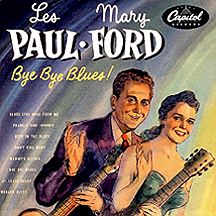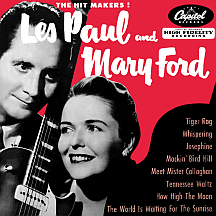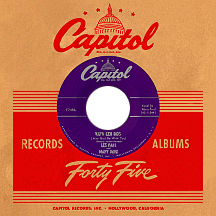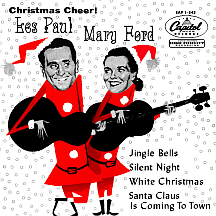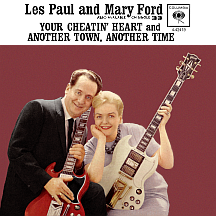LES PAUL AND MARY FORD
"Tinkering" is a word Les Paul sometimes used to describe his favorite pastime. From childhood he had a natural inclination to modify (at the risk of ruining) radios, musical instruments and various electronic devices, often using simple household items. He once connected some spare telephone parts to make a homemade microphone. He figured out a way to attach his acoustic guitar to a pair of speakers placed on opposite ends of the room (or a stage) for a two-channel stereophonic effect (this was in the late 1920s, quite a few years before the development of stereo as we know it). Many guitars were altered in various ways to make unusual sounds. He built a turntable with a Cadillac flywheel and made it into a primitive recording machine, then accompanied his own playing on the discs he'd cut. He ultimately built and marketed the most popular solid body electric guitar of all time...named after himself, of course. This "mad genius" behavior didn't stop; Les built studios and had a ball with the reel-to-reel tape decks that became popular after World War II, rigging them up to make sound-on-sound and stereo recording more accessible. While he was at it, he made a lot of records...some of them million sellers. In short, Les Paul was one of music's greatest inventors, or should I say tinkerers, of the 20th century.
"The Wizard of Waukesha" became his nickname at some point; surely no one else in his Wisconsin hometown could claim to be on such a level of musical magicianship. Lester Polsfuss would have been an awkward stage name, so he changed it during his teens, taking on a few very odd identities before arriving, much later, at the obvious economical moniker. He played banjo and harmonica and worked in his father George's garage, while making use of all sorts of tools to aid in his adjustments of gadgets. Loving mother Evelyn supported his interest in music and bought him a Troubadour guitar from the Sears catalog when he was 12. Red Hot Red (carrot-top alert!) became the first of those wacky names at age 13; soon he was playing around town for tips, sometimes bringing home 30 dollars or more in a single week. Often found in front of the radio, he was especially drawn to bluesmen like Delford Bailey (a Nashville-based singer of the mid-1920s who was the first black performer on 650 WSM radio's Grand Ole Opry) and blues harp specialist Sonny Terry.
Another singer who caught Lester's ear was Pie Plant Pete (a.k.a. Claud Moye), a master of guitar and harmonica featured on the National Barn Dance program heard on WLS 870 in Chicago and throughout several midwestern states around 1928. Within a year, inspired by his hero, Les took on a similarly unusual plant/food name: Rhubarb Red. On a tour stop in Waukesha, Pete demonstrated some of his playing technique to the young musician; major star Gene Autry also passed on some tips to Les when he was in town. Joe Wolverton, an Indiana-born guitar, banjo and violin player, formed a duo with Les (as Sunny Joe and Rhubarb Red) around 1932; the pair hit the road and wound up in Chicago, where they made dozens of transcription discs for repeated use on radio. Les, at just 17 years of age, had a daytime country show on WJJD (1130 on the dial) and a nighttime jazz show on 560 WIND.
While they were performing at the 1933 Chicago World's Fair, Sunny Joe decided to move out west while Les stayed and got involved in Chicago's jazz scene (an interest he'd had since discovering Belgium-born, Paris-based guitarist Django Reinhardt). Les played on a number of sessions, mainly backing Decca artists (Louis Armstrong, Art Tatum and others), before recording his first 78 RPM as Rhubarb Red ("singing with guitar and harp") in the spring of 1936. "Just Because" (written by Joe and Bob Attlesey and Leon Chappelear of The Lone Star Cowboys) was issued on the Montgomery Ward label (guess where those were sold!). Soon afterwards he shortened his name and formed The Les Paul Trio with bassist Ernie Newton and vocalist-guitarist Jim Atkins. Over a span of several years, performing with the trio and backing Fred Waring's Pennsylvanians and other bands, Les had become more nationally known. Between '43 and '45, he performed with some of the biggest stars of the era on broadcasts for Armed Forces Radio.
Gradually shifting from jazz to the more lucrative pop music field, and continuing to piece together his own musical devices, Les famously performed as part of the first Jazz at the Philhamonic concert in Los Angeles on July 2, 1944, an all-star event led by Nat "King" Cole and tenor saxophonist Illinois Jacquet. Recordings for Decca followed under the Les Paul name, starting with Cole Porter's "Begin the Beguine" (an instrumental) in the summer of 1945 and peaking with the Jule Styne-Sammy Cahn song "It's Been a Long Long Time" by Bing Crosby with Les Paul and his Trio, a credited collaboration that became a number one hit in January '46. But let's backtrack slightly for a moment. Something else happened in 1945: he met the love of his life.
Les and a few other inventor pals built a studio...right inside his garage. Though it only cost about 400 dollars, some top-tier music acts (Jo Stafford, Kay Starr) were anxious to warble there. He'd been planning to do some country and western radio programs and needed a female vocalist; El Monte singer (and divorcee) Iris Colleen Summers showed up for the gig, professing to be a big fan of Les (he didn't believe her); he nicknamed her "Mary Lou" on the spot, referring to her "country" manner. They recorded the shows and professionally went their separate ways. But personally, sparks started to fly, Colleen the fan and Les the guitar-slinging star. Their showbiz connection was one he hadn't developed with wife Virginia; after about a year he left her and their two young sons, though not to marry Iris...or Colleen...or Mary Lou, or whatever name she was using at that time. He wasn't interested in getting divorced twice.
In the fall of '46, The Andrews Sisters had a top ten single, "Rumors Are Flying," that originated in Les's garage studio with his guitar work credited on the label; a tour with the superstar girl group followed. Meanwhile, other artists had begun copying his style of playing, so he put the trio on hold and hunkered down in his garage, using self-made inventions to come up with a sound no one would be able to accurately imitate...or rip off, whichever phrase sounds more bluntly appropriate. After about a year without releasing any new material, he took some demos to Decca, but they didn't "get it." Using every trick he'd come up with since the late '20s, Les created new ways to multitrack, playing all the instruments. The result was a very unique sound. After playing his music for Jim Conklin at Capitol Records, he was signed on the spot.
"Lover," an instrumental version of Richard Rodgers and Lorenz Hart's 15-year-old standard, was his Capitol debut in early 1948; it was well-received, though bewilderment over the technique became a common reaction. Les played every instrument, even the drums. He didn't need a trio anymore...he'd become a much larger band all by himself! A portable sound mixer built by a friend helped streamline the recording process...but the public wasn't made aware of this gadget or the dozens of others that were fated to signal the direction popular music was moving in. His next single, "Hip-Billy Boogie" (co-written with his pal, songwriter Fos Carling), appeared about the same time as a Les Paul Trio disc on the Mercury label, "My Extraordinary Gal."
Later that year, while driving back to L.A. after visiting the Polsfuss family in Waukesha, Les and "Mary Lou" were in an auto accident near Oklahoma City. She was fine, but Les was a mess: back, collarbone, broken ribs, a ruptured spleen, fractured pelvis. He was laid up for about a year and a half, trapped for quite awhile in a body cast, and his right arm, which had been crushed, was rebuilt with a hinge and several metal screws. He had lots of time to think and make notes...and come up with ideas for future inventions. As soon as he could play again, his steadfast girlfriend Colleen...or whatever it was he called her...started backing him on her own guitar. They tried out the new act at a small club in Milwaukee, word got around and soon they were playing to a packed house. Reactions to her singing were favorable, so they came up with a professional alias: Mary (without the "Lou") and Ford (which Les picked out of a phone book). The names rolled off the tongue: Les Paul and Mary Ford. One other thing: they were finally married, in Milwaukee, on December 29, 1949.
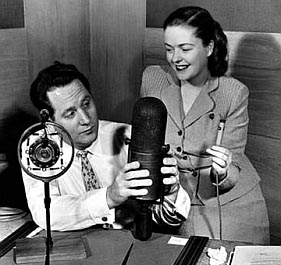
The Les Paul Show aired on NBC radio in 1949 and 1950, each running a quarter hour over the course of 23 weeks. Some were taped and sent to the network while they were touring; the show served as a testing ground for a lot of the songs that became hits. Les, quite the practical joker, began demonstrating how he multitracked the instruments (and Mary's voice) using his magic "Les Paulverizer" (at one point Mary supposedly tried to vacuum the floor with it as part of the gag). In reality it wasn't as easy as they made it seem (none of his actual secrets were revealed), but the bit was popular with listeners.
Their songs began breaking onto the charts at a steady clip: "Nola," "Goofus" and "Little Rock Getaway," all Paul instrumentals, were major hits between mid-1950 and early '51. The flip of the latter, "Tennessee Waltz," came about after Les noticed Patti Page had been doing her own equivalent to his multiple-voice trick; he decided to record the song with Mary, figuring to beat Page on his terms...which didn't work. Patti's version was a real chartbuster, the biggest seller of the entire year. A few months later, in the spring of 1951, Les and Mary released "Mockin' Bird Hill" (written by Vaughn Horton, who based it on a melody by Swedish accordionist Calle Jularbo); Mary wasn't crazy about the 'twiddle-ee-dee-dee' song but agreed to do it. Then Patti put out a cover and they went head-to-head on the charts, ending in a photo-finish with the Paul/Ford version doing slightly better.
"How High the Moon," a song penned by Broadway tunesmith Morgan Lewis and actress-songwriter Nancy Hamilton, was introduced in Broadway's 1940 production of Two For the Show. Les and the trio had made a version for one of the many V-Discs they'd recorded for WWII soldiers; Stan Kenton and a scatting June Christy had a minor hit with it in 1948. The song's curious lyrics were implemented by Les with a swirl of Marys singing at once ('Somewhere there's music, how faint the tune...somewhere there's heaven, how high the moon...how near, how far...hii-iii-iii-iiiii-iii-iii-iiiii-iigh...'). Capitol honchos weren't convinced it had hit potential, but Les proved them wrong. The single shot to number one in April '51 and stayed there for nine weeks, the longest dominance to that point in the label's nine year history. People couldn't figure out how they achieved this wild sound, but they sure liked it!
Solo instrumentals by Les usually appeared on the flip sides of vocal recordings and were hits in their own right. The class of '51 included "Josephine," "Whispering" and another vocal hit, "The World is Waiting For the Sunrise," a 30-year-old song by classically-trained Canadian composer Ernest Seitz with lyrics by Oscar-nominated actor Gene Lockhart (his specialty: playing a snitch!). Done in a style identical to "How High," it capped 1951 as the biggest year yet for the Pauls...or Fords, whichever you prefer. Touring demands were stronger than ever; Les bought a Cadillac to celebrate, then loaded it with instruments and electronic gadgets to take on the road for use onstage.
Solid body acoustic guitars had been developed by various companies since the mid-1930s, but Les was the guy who decided a solid body electric that delivered superior sound was a possibility. In the early '40s he modified an Epiphone model and frequently performed with it, eventually convincing the Gibson company such an instrument could be marketed successfully. In 1952 the first Les Paul solid body electric guitar hit the market appearing noticeably different from the competing Epiphone brand. Other models were designed by Les throughout the 1950s (including a nifty white guitar favored by Mary Ford) and custom models had names like "Black Beauty" and "Fretless Wonder." Emerging rock and roll guitarists starting showing a preference for Les Paul guitars.
Les and Mary moved to Mahwah, New Jersey (just outside New York City) and bought a house, tricking it out with a studio-type setup in nearly every room. A daily five minute syndicated television show, Les Paul and Mary Ford at Home, premiered in the spring of 1952 and ran through the end of the year, with all 170 episodes filmed at the Mahwah house. In addition there was a five minute radio series, featuring different content, heard on many stations across the U.S. Hits in '52 included "Tiger Rag" (an Original Dixieland Jazz Band classic from the first World War); while working out the song in the house, the couple cranked the sound so loud, with Mary's vocals ('Here, kitty-kitty-kitty...') practically shaking the walls. Neighbors called the cops, who arrived, liked what they heard and allowed them to continue. Instrumental hits that year included "Carioca," "Lady of Spain" and the most popular of Les Paul's solo discs, "Meet Mister Callaghan" (a British crime/detective movie theme penned by Eric Spear).
"Bye Bye Blues" and "I'm Sitting on Top of the World" were top sellers in early 1953, then came the ultimate coup. Cool jazz chick Anita O'Day recorded "Vaya Con Dios (May God Be With You)" for Mercury early in the year. A serene song ('Now the hacienda's dark, the town is sleeping...now the time has come to part, the time for weeping...') written by movie studio songwriters Larry Russell, Inez James and Buddy Pepper, the Paul and Ford treatment spent eleven weeks at number one from August to October. Their career peak. The Capitol label's all-time biggest hit, in fact...a record that still stands.
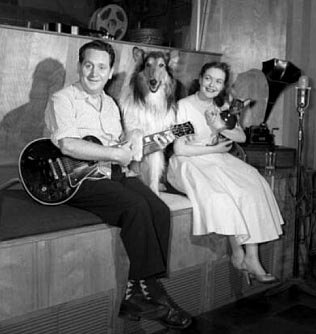
As much as Mary enjoyed making music in the comfy confines of a studio and/or her own home, she was not fond of performing live. By this time she was ready to retire from show business, but Les had always been career driven and demanded she keep up with him. Recording, performing, being on TV, radio and in front of audiences, inventing new gadgets, refining his technique, plus overseeing the process of manufacturing his guitars to precise standards consumed most of his time and energy. He began work on an eight-channel tape machine and at some point turned the Paulverizer gag into a real thing, a "black box" on the guitar he could use to perform many tricks (overdubbing, sound effects, reverb) in real time.
In '54 the duo enjoyed hits with Don Robertson and Howard Barnes' "I Really Don't Want to Know," Ted Daffan's "I'm a Fool to Care" and Guy Singer's "Whither Thou Goest." Another song by Capitol artist/whistler Robertson, "Hummingbird," returned Les and Mary to the top ten in '55. "Moritat (Theme from 'Three Penny Opera')" was the final instrumental hit for Les in '56. The eight track machine became a reality in '57; Ampex made and marketed the product, which helped streamline the recording process and gradually gained favor among artists and producers.
In 1958 they left Capitol and signed an exclusive contract with rival label Columbia. "Put a Ring on My Finger" reached the top 40, but follow-ups fared poorly. It was nearly three years before they managed another top 40 ranking with "Jura (I Swear I Love You)," a remake of a song written in 1928 by Brazilian composer Sinho (born Jose Barbosa da Silva); their version fit in well with an emerging '60s trend towards international pop melodies. The glory days were long over...and their marriage was soon to be as well. Okay, so "love of his life" is perhaps a strong phrase...the "ultimate love match" had lost its lustre. In the later years, Mary had a number of indiscretions. Les's mistress was his electronic equipment; his passion for finding new breakthroughs in recorded sound (and perhaps a tendency to imbibe) occupied every waking moment. Putting it mildly, she found other shoulders to lean on. He filed for divorce. She was okay with it. The split was legally finalized in December 1964.
An attempt at a solo career had already been made: in 1963, Mary released an English language cover of The Singing Nun's massive hit "Dominique" for the Calendar label. There were a few more post-divorce efforts; a nice single-tracked vocal cover of Jim Reeves' hit "This is It" (penned by Cindy Walker) came in '65. She returned to Capitol with a 1966 single on their Tower imprint, "One in a Million," produced by Bob Crewe and her younger brother Bob Summers in a trendy "girl pop" style. Walker's "Gringo's Guitar," on the small Carole label, appeared in '67. None of these caught on despite solid production values and fine (single-tracked!) vocals by Mary...Colleen...or whatever family and friends were calling her at that time. In 1968, Les recorded the album Les Paul Now! for London Records, featuring newer "phase 4 stereo" versions of several of his early hits. In 1976, he had a blast doing the LP Chester & Lester for RCA with guitar legend Chet Atkins (former trio partner Jim's brother), featuring dual-guitar versions of classic instrumentals. The album won a Grammy in the category Best Country Instrumental Performance. He continued designing new guitars for Gibson under the Les Paul line through the 1970s.
Mary Ford's end came much too soon: a diabetic, she went into a coma in 1977, dying on September 30 of that year at the age of 53. Starting in 1984 and for many years afterwards, Les performed Monday nights at Manhattan jazz club Fat Tuesday's. The wheels in his mind turned constantly for 94 years; he became a hero of rock musicians from the '60s onward for his many inventions, guitars in particular. In fact, you can credit Les Paul with trailblazing many of the progressive innovations in music over the last century.
NOTABLE SINGLES:
- Just Because - 1937
as Rhubarb Red - Begin the Beguine - 1945
by Les Paul - It's Been a Long Long Time - 1945
by Bing Crosby with Les Paul and his Trio - Blue Skies - 1946
by Les Paul and his Trio - Rumors Are Flying - 1946
by the Andrews Sisters with Les Paul - Lover - 1948
by Les Paul - Hip-Billy Boogie - 1948
by Les Paul - My Extraordinary Gal - 1948
by the Les Paul Trio - The Swiss Woodpecker - 1948
by Les Paul - Dry My Tears - 1950
- Nola - 1950
by Les Paul - Goofus - 1950
by Les Paul - Little Rock Getaway
by Les Paul /
Tennessee Waltz - 1951 - Mockin' Bird Hill - 1951
- How High the Moon - 1951
- Josephine - 1951
by Les Paul - The World is Waiting For the Sunrise /
Whispering - 1951
by Les Paul - Just One More Chance /
Jazz Me Blues - 1951
by Les Paul - Jingle Bells - 1951
by Les Paul - Tiger Rag - 1952
- I'm Confessin' (That I Love You) /
Carioca - 1952
by Les Paul - In the Good Old Summertime /
Smoke Rings - 1952 - Meet Mister Callaghan
by Les Paul /
Take Me in Your Arms and Hold Me - 1952 - Lady of Spain
by Les Paul /
My Baby's Coming Home - 1952 - Bye Bye Blues - 1953
- I'm Sitting on Top of the World - 1953
- Vaya Con Dios (May God Be With You) - 1953
- I Really Don't Want to Know - 1954
- I'm a Fool to Care - 1954
- Whither Thou Goest - 1954
- Hummingbird - 1955
- Amukiriki (The Lord Willing) /
Magic Melody - 1955 - Texas Lady - 1956
- Moritat (Theme from "Three Penny Opera") - 1956
by Les Paul - Cinco Robles (Five Oaks) - 1957
- Put a Ring on My Finger - 1958
- Jealous Heart /
Big Eyed Gal - 1958
as Les Paul Plays Many Many Guitars - Jura (I Swear I Love You) - 1961
- Dominique - 1963
by Mary Ford - This is It - 1965
by Mary Ford - One in a Million - 1966
by Mary Ford - Gringo's Guitar - 1967
by Mary Ford - Los Angeles - 1968
by Les Paul


